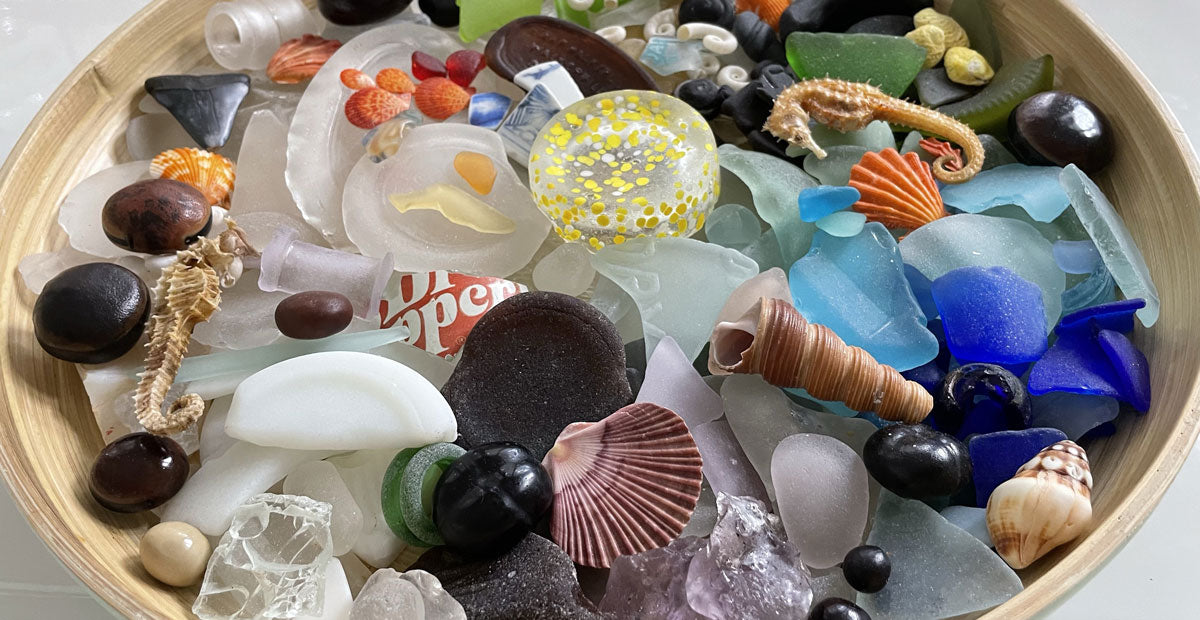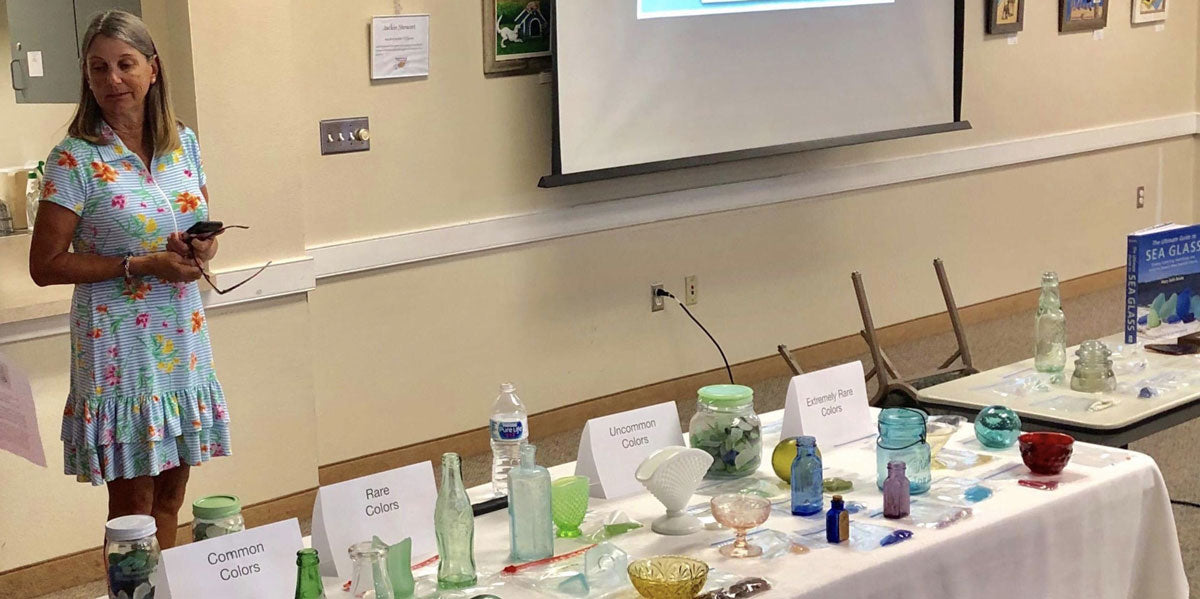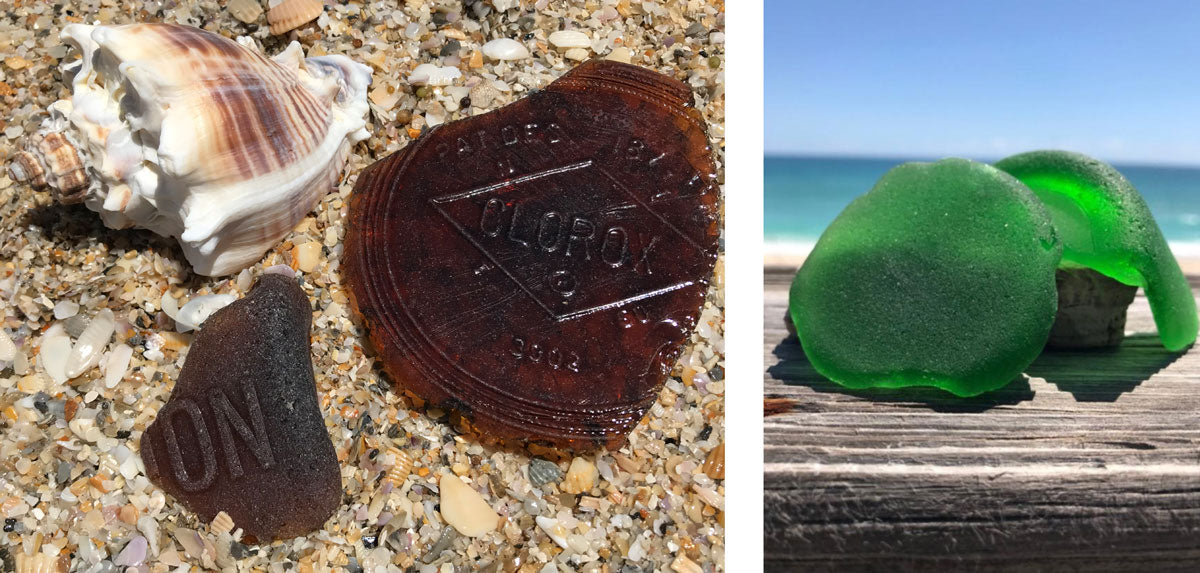The Colors and Rarity of Sea Glass
By Ann Fisk
 Beachcomber Ann Fisk has been collecting sea glass and seashells for years. She belongs to Florida’s East Coast Sea Glass Club, where she has shared a presentation about sea glass colors and their sources. Her talk includes information about where sea glass comes from (mostly from bottles), the most common colors (mostly from mass-produced bottles), rare colors (mostly from tableware), and information on dating your sea glass finds (look for bubbles in thick glass to find the oldest pieces).
Beachcomber Ann Fisk has been collecting sea glass and seashells for years. She belongs to Florida’s East Coast Sea Glass Club, where she has shared a presentation about sea glass colors and their sources. Her talk includes information about where sea glass comes from (mostly from bottles), the most common colors (mostly from mass-produced bottles), rare colors (mostly from tableware), and information on dating your sea glass finds (look for bubbles in thick glass to find the oldest pieces).

One of the fun parts of Ann’s presentation is her use of photography to illustrate where the different sea glass colors typically originated, showing a historical piece next to sea glass from her collection. Following is just some of the information about sea glass colors from Ann’s talk.
Common Colors

Brown
Beverage and medicine bottles.
Clear
Milk and soda bottles, window glass, jars.
Kelly Green
Beer and soda bottles.
Uncommon Colors

Sea Foam Green
Coca-Cola, beer, and soda bottles.
Soft Blue
Jars, medicine bottles, window glass.
Forest Green
Wine bottles, glass fishing floats.
Amber
Liquor, medicine, and cleaning product bottles, as well as some decorative glass.
Lime Green
Lemon-lime soda bottles and tableware. Vaseline Glass or Canary Glass containing uranium glows under UV light.
Rare Colors

Opaque White, Green, Blue, Pink, Yellow
Tableware, cosmetic jars, and art glass.
Cornflower Blue
Early medicine or cure bottles, tableware, cosmetic bottles and jars.
Pink
Tableware and decorative pieces. Some clear glass containing manganese turns pink in sunlight over time.

Purple
Amethyst-colored decorative pieces and tableware. Some clear glass containing manganese turns purple in sunlight over time. True purple glass has manganese and iron.
Cobalt Blue
Medicine, poison, and cosmetic bottles and jars, as well as some decorative pieces and tableware.
Citron
Oil, wine, and food containers and bottles.
Aquamarine
Canning jars, electrical insulators, and soda, mineral water, and medicine bottles.
Extremely Rare Colors

Gray
Tableware and flat glass. True Gray glass contains iron oxide or selenium. Clear glass containing lead turns gray in sunlight over time.
Black
Bottles from the 1700s to 1800s were made with dark olive green or dark amber glass—that often looks black—to protect contents from sunlight. Amethyst glass and insulator glass are dark purple but can appear black.
Teal
Mineral water, ink, wine, and sauce bottles. Sake bottles and glass fishing floats from Japan.

Yellow
Tableware and decorative pieces. Some clear glass containing selenium turns yellow in sunlight over time. Vaseline Glass or Canary Glass containing uranium glows under UV light.
Red
Auto, railroad, and marine lights, as well as Victorian lamps, decorative pieces, and tableware.
Orange
Decorative pieces and auto and marine reflectors. Not widely used in commercial bottles.

Turquoise or Electric Blue
Decorative glass, seltzer bottles, pressed glass, and bottles.
Thanks to Ann for sharing her presentation and her collection!
Ann Fisk would like to thank Richard LaMotte for the sea glass color rarity information in her article. You can find the information and more in the Pure Sea Glass Identification Deck by Richard LaMotte. Ann has enjoyed meeting Richard at sea glass festivals and, like many in the beachcombing community, considers him the expert on sea glass identification.
Watch videos about all the colors of sea and beach glass
Learn more about sea and beach glass colors:
This article appeared in the Beachcombing Magazine September/October 2022 issue.








